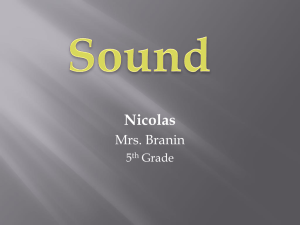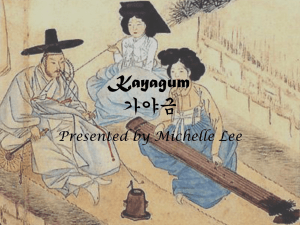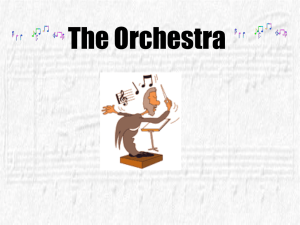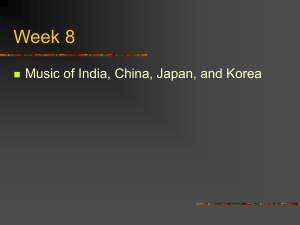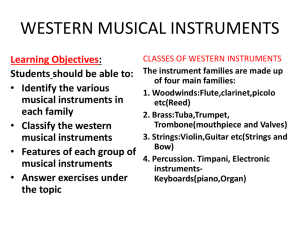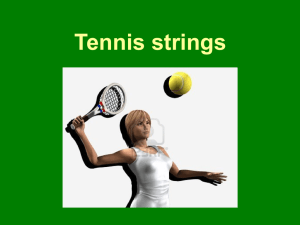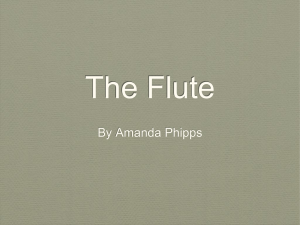PPT About Chinese Musical Instruments
advertisement
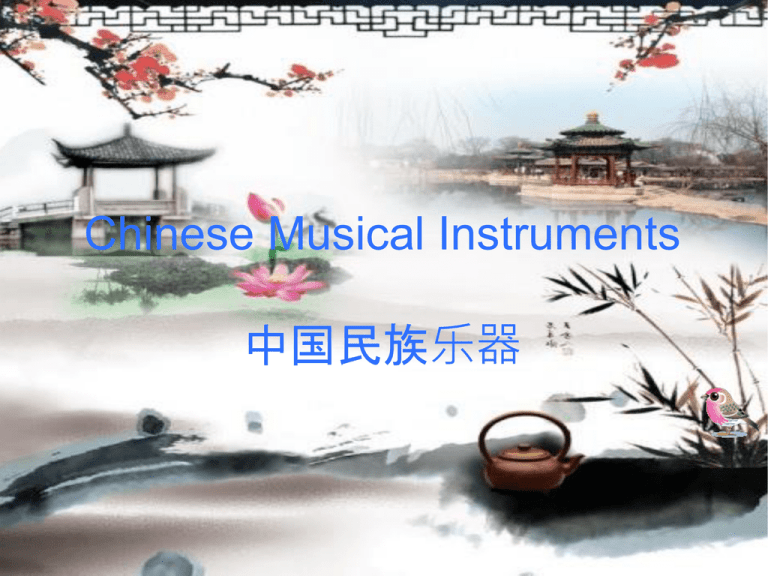
Chinese Musical Instruments 中国民族乐器 History According to incomplete statistics, China now has more than 600 varieties of National musical instruments with unique characteristics.The se traditional National musical 2 Twelve Girls Band 女子十二乐坊 Jasmine Flower 茉莉花 (0:27-1:43) COMPOSITION OF INSTRUMENTS IN TWELVE GIRLS BAND ★ Four Erhu 二胡 ★ Three Chinese Lute(Pipa) 琵琶 ★ Two Bamboo Raft 竹笛 ★ Two Dulcimer(Yang-chin) 扬琴 ★ One Ancient Zither(Gu’zheng) 古筝 CATEGORY according to the style of performing • Bowed • Plucked Strings • Wind • Percussion Erhu • Erhu is a Chinese musical instruments, the youngest .But the Erhu is a bowed instrument that has become the most widely spread and most representative in China.The Erhu has a soft sound.It is suitable for playing soft and meticulous lyrical music.It is a solo musical instrument with rich impressive forces。 • The erhu consists of a long vertical stick-like neck, at the top of which are two large tuning pegs, and at the bottom is a small resonator body (sound box) which is covered with python skin on the front (playing) end. Two strings are attached from the pegs to the base, and a small loop of string (qian jin) placed around the neck and strings acting as a nut pulls the strings towards the skin, holding a small wooden bridge in place. Plucked string instrument • Plucked string instruments, according to the shapes, performance,and playing methods of musical instruments ,plucked string instruments can be divided into two categories:one represented by the pipa,and the other the guqin and guzheng。 8 The earliest guqin had five string.Emperors Wenwang and Wuwang of Zhou Dynasty knew music well enough to add two strings to guqin. That’s why the guqin usually has seven strings. The guzheng is one of the oldest Chinese plucked string instrument.The most commonly used one has 21 strings. 9 • 琵琶 pipa When it is played,the left hand controls the strings,and the right hand plays it. 10 Ruan The ruan (阮) is a Chinese plucked string instrument. It is a lute with a fretted neck, a circular body, and four strings. Its four strings were formerly made of silk but since the 20th century they have been made of steel (flatwound for the lower strings). The modern ruan has 24 frets with 12 semitones on each string, which has greatly expanded its range from a previous 13 frets. In Chinese orchestras, only the zhongruan and daruan are The ruan comes in a family of five commonly used, to fill in the tenor and bass section of the sizes: plucked string section. Occasionally the gaoyinruan is used to •Soprano: Gaoyinruan (高音阮, lit. substitute the high-pitched liuqin. "high pitched ruan"; tuning: G3-D4G4-D5) •Alto: Xiaoruan (小阮, lit. "small ruan"; tuning: D3-A3-D4-A4) •Tenor: Zhongruan (中阮, lit. "medium ruan"; tuning: G2-D3-G3D4) •Bass: Daruan (大阮, lit. "large ruan"; tuning: D2-A2-D3-A3) •Contrabass: Diyinruan (低音阮, lit. "low pitched ruan"; tuning: G1-D2G2-D3) 11 Chinese Wind instruments • Bone flutes Unearthed from remains of the neolithic Age at Jiahu Village,Henan Province between 1986 and 1987,are the most ancient musical instrument discovered by archeologists in china。About 7500 years ago。 12 The flute is also known as the cross flute or bamboo flute. Traditional flute are mainly made from bamboo. The flute has six tone holes, one blowing hole and one flute diaphragm hole. Hulusi (葫芦丝) – free-reed wind instrument with three bamboo pipes which pass through a gourd wind chest; one pipe has finger holes and the other two are drone pipes; used primarily in Yunnan province 13 The paixiao (排箫) is an ancient Chinese wind instrument, a form of pan pipes. Sheng (笙) – free reed mouth organ consisting of varying number of bamboo pipes inserted into a metal (formerly gourd or hardwood) chamber with finger holes The Xun (埙) is a globular, vessel flute from China. It is one of the oldest musical instruments in China and has been in use for approximately seven thousand years. The xun was initially made of baked clay or bone, and later of clay or ceramic. 14 Paigu (排鼓) – set of three to seven tuned drums played with sticks Percussion -Made with Hide Dagu – (大鼓) – large drum played with two sticks Bangu (板鼓) – small, high pitched drum used in Beijing opera 15 Percussion -Made with Metal Yunluo ( 云锣) – literally "cloud gongs"; 10 or more small tuned gongs in a frame Bianzhong (编钟) – 16 to 65 bronze bells hung on a rack, struck using poles Dulcimer (Yangqin) Belongs to Plucked string and Percussion instruments Strings Modern yangqin usually have 144 strings in total, with each pitch running in courses, with up to 5 strings per course, in order to boost the volume. The strings come in various thicknesses, and are tied at one end by screws, and at the other with tuning pegs. The pegs and screws are covered during playing by a hinged panel/board. This panel is opened up during tuning to access the tuning pegs. Bridges There are usually four to five bridges on a yangqin. From right to left, they are: bass bridge, "right bridge", tenor bridge, "left bridge", and the chromatic bridge. During playing, one is supposed to strike the strings on the left side of the bridges. However, the strings on the "chromatic bridge" are struck on the right, and strings on the "left bridge" can be struck on both sides of the bridge. Hammers The hammers are made of flexible bamboo, and one end is half covered by rubber. Due to their unique construction, there are two ways to play: with the rubber side for a softer sound, and with the bamboo side for a crisper, more percussive sound. This technique, known as (fǎnzhǔ), is best utilized in the higher ranges of the yangqin. Additionally, the ends of the sticks can be used to pluck the strings, producing a sharp, clear sound. Glissandos can also be achieved in this way by running the ends of the sticks up or down the strings Cylindrical nuts On both sides of the yangqin, aside from the tuning screws, are numerous cylindrical metal Nuts that can be moved for fine tuning the strings or to raise the strings slightly to eliminate unwanted vibrations that may occur. Manner of Performance • The sticks are held, one in each hand, and hit the strings alternately. In the orchestra, the yangqin often adds to the harmony by playing chords or arpeggios. As the yangqin is softer than other Chinese instruments, it is usually positioned at the front of the orchestra, in the row just in front of the conductor. The yangqin has been called the "Chinese piano" as it has an indispensable role in the accompaniment of Chinese string and wind instruments. The yangqin is a chromatic instrument with a range of slightly over four octaves. Middle C is located on the tenor bridge, third course from the bottom. The pitches are arranged so that in general, moving one section away from the player's body corresponds to a transposition of a whole tone upwards. Similarly, moving one section towards the left of the performer generally corresponds to a transposition of a perfect fifth upwards. These are only rules of thumb since the arrangement has to be modified towards the extremes of the pitch range to fill out notes in the chromatic scale. Such an arrangement facilitates transposition. Moonlit River In Spring 29 谢谢 Thanks~
